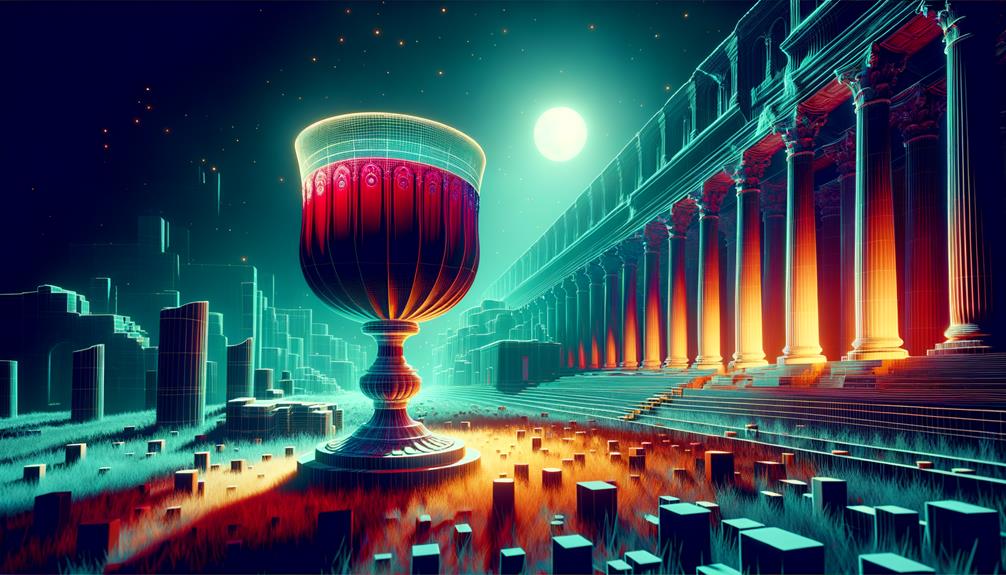Isn't it fascinating how the past continues to baffle us? Take the Lycurgus Cup for instance, a Roman goblet that keeps historians guessing. Its unique trait? Shifting colors when light hits it, thanks to embedded gold and silver nanoparticles. This green-to-red transformation is a testament to the Romans' advanced skills in manipulating light. It's proposed that they achieved this by incorporating gold and silver into hot glass.
But this cup isn't just a marvel of ancient manufacturing. It also narrates a captivating story through its color-shifting imagery of King Lycurgus attacking Ambrosia—a tale linked to Bacchic cult rituals. We're still working on understanding the full narrative, as the cup's exact origins and how it was made remain a mystery.
This intriguing artifact now resides in the British Museum. As we continue to unravel its secrets, we're sure to gain more insight into this intriguing piece of age-old craftsmanship that beautifully blends art and science.
The Enigma of Dichroic Glass
Let's delve into the captivating world of dichroic glass. Have you ever heard of the Lycurgus Cup? This extraordinary piece, made from a unique type of glass, has an intriguing ability. It changes color from a solid green to a see-through red. Now, you might be wondering, how does that happen? Well, when light interacts with the gold and silver nanoparticles in the glass, this magical transformation occurs.
You see, the secret lies in the energy shifts within the gold particles. The Romans, who were pretty clever, knew how to play around with these particles during the creation process, resulting in this jaw-dropping dichroic effect. The Lycurgus Cup is a testament to their deep understanding and expertise. It demonstrates their ability to manipulate light and matter into creating such a mesmerizing artifact.
Manufacturing Techniques: Ancient and Modern
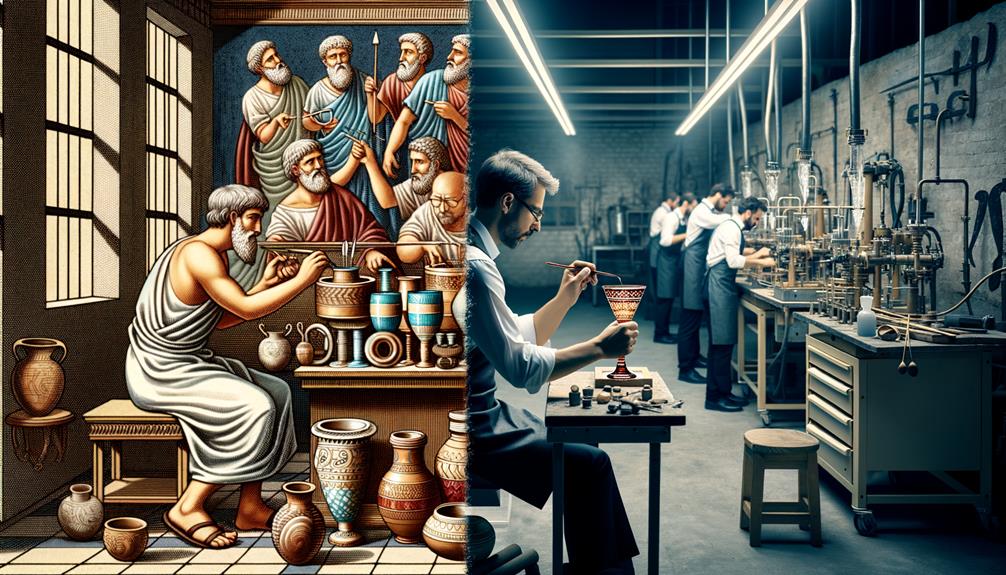
Let's take a moment to journey back in time and appreciate the magnificent glass-making skills of the ancient Romans, contrasting them with the advanced techniques that we use today. Our point of interest: the enigmatic dichroic glass. This captivating technology was lost in the sands of time, only to be unearthed again for use in modern space-age applications.
Believed to be akin to ancient alchemists, the Romans probably mixed tiny specks of gold and silver into hot molten glass. They repeatedly thinned out these mixtures, reaching the minuscule proportions seen in the Lycurgus Cup. This unique cup, now a prized possession of the British Museum, has a peculiar ability to alter its color from green to red, depending on the direction of the light.
Let's draw a comparison between these traditional and contemporary techniques:
| Roman Technique | Modern Technique | Outcome |
|---|---|---|
| Mixed gold and silver particles with hot molten glass | Use of nanotechnology to infuse gold and silver particles | Dichroic Glass |
| Consistently thinned out to reach minuscule proportions | Precise measurements and processes control | Miniature versions of the Lycurgus Cups |
| Uncertain if the color-changing attribute was deliberate | Specific properties are engineered intentionally | Regulated light and color effects |
Whether it was a happy accident or a result of their genius, the ancient Roman King's cup gives us a peek into their forgotten expertise in glass-making.
The Lycurgus Cups Iconography
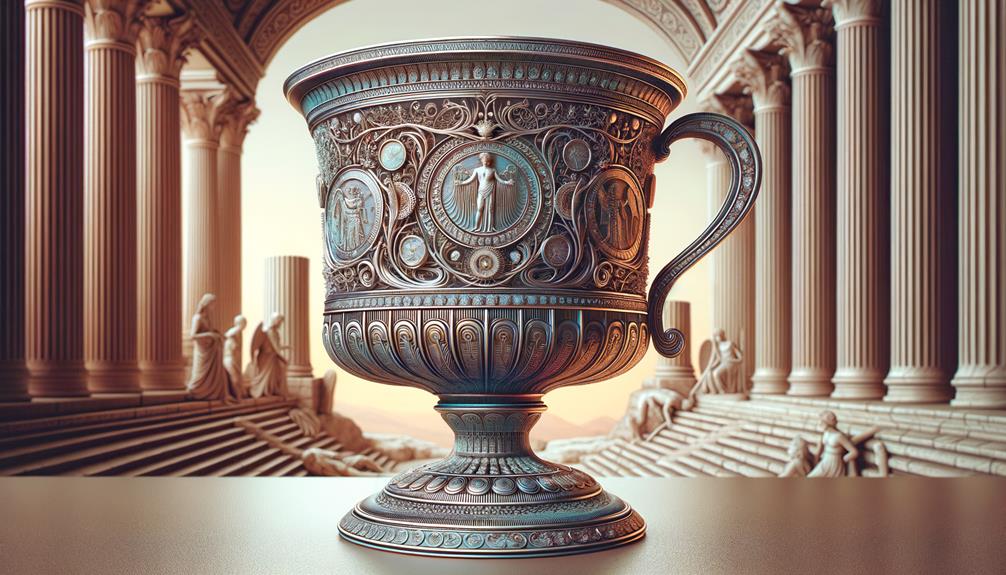
Taking a closer look at the Lycurgus Cup, you'll find yourself immersed in a world of ancient myths. The story it tells, of King Lycurgus' assault on Ambrosia, is a fascinating mix of symbolism and religious themes. The cup's design, featuring a vine entanglement, presents a unique take on the myth, a departure from the usual portrayal of King Lycurgus with a double-headed axe.
But here's the kicker, the cup's color-changing property, moving from green to red, isn't just a cool trick. It's likely to symbolize the ripening of red grapes, linking the cup to Bacchic cult celebrations. So, the Lycurgus Cup isn't just a religious artifact. It's a storytelling tool that deepens our understanding of Roman religious customs. The way it weaves together narrative, design, and symbolism, it's more than just a cup – it's a window into another time.
Historical Journey of the Cup
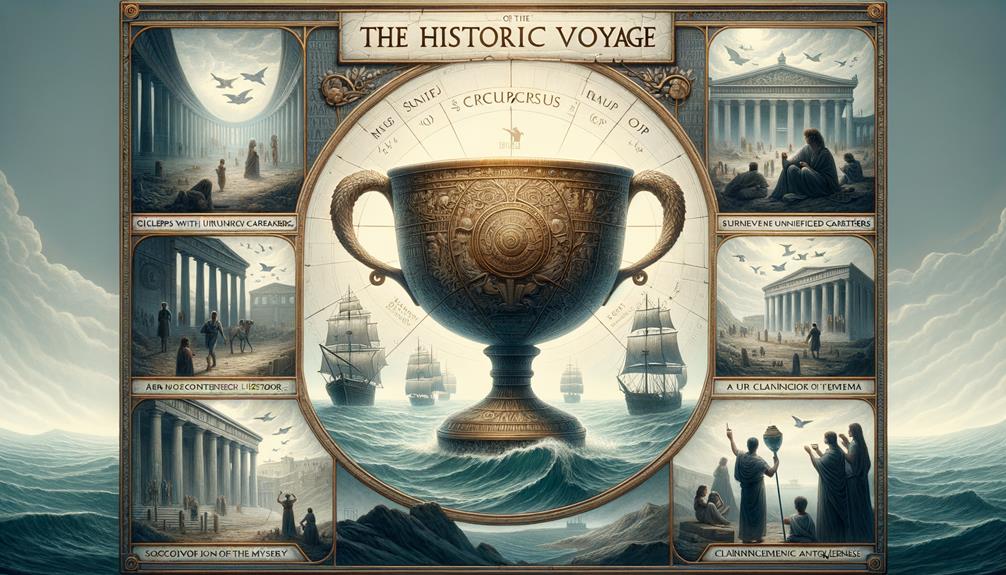
If we follow the intriguing trail of the Lycurgus Cup, we'll find ourselves stepping back in time, all the way to its birth in the 4th century CE, likely in Alexandria or Rome. Today, this Roman caged cup, a precious rarity, finds its home in the British Museum. With dimensions of 16.5cm x 13.2cm, it presents a captivating scene from a myth: Lycurgus' attack on Ambrosia, who's engulfed by a vine. The British Museum secured this well-preserved artifact in 1958, at a cost of £20,000, adding to its unique appeal. Where exactly it came from, whether a burial chest or a church vault, remains an engaging enigma. Even though the cup's past is shrouded in mystery, it offers us a snapshot into our rich history, affirming its value as an irreplaceable piece of our cultural heritage.
Scientific Analysis of the Cup
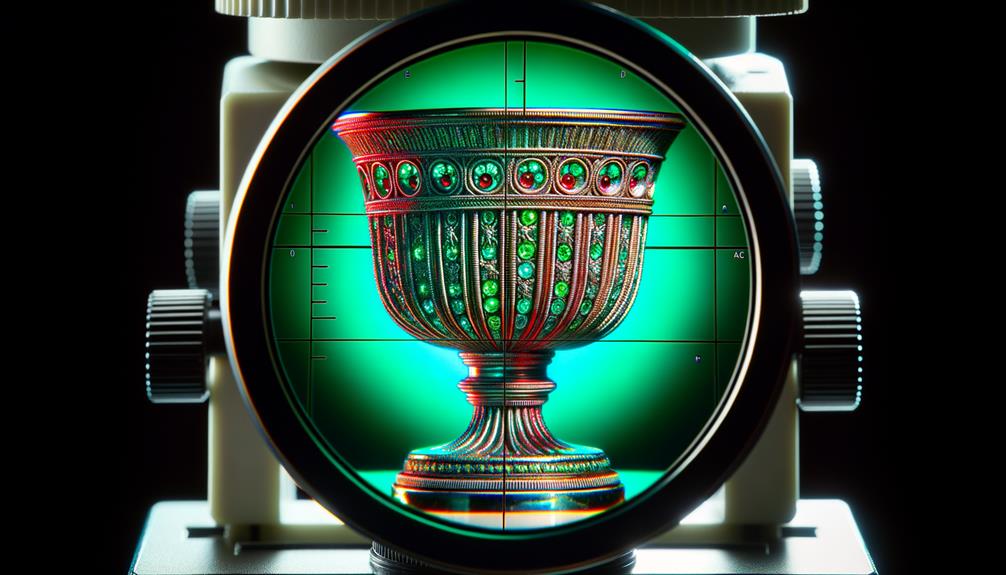
If we take a closer look at the Lycurgus Cup, an ancient Roman artifact kept at the British Museum, we find an exciting intersection of nanotechnology and old-world artistry. This cup isn't just a testament to the finely-honed skills of Roman artisans; it's also a riddle that puzzled scientists until the 1990s.
What's the secret behind the cup's color change? Let's look at the three key elements:
- Gold Nanoparticles: The color of the cup shifts due to an energy shift caused by gold nanoparticles.
- Silver Nanoparticles: Silver nanoparticles also play a vital role in this extraordinary color transformation.
- Nanotechnology: This advanced technique is a testament to the Romans' advanced understanding of materials, quite an achievement for their time.
Frequently Asked Questions
What Is the Lycurgus Cup Mystery?
I'm currently intrigued by a remarkable relic that can change its color. The secret behind this spectacle lies in the tiny particles of gold and silver in its makeup. What's truly perplexing is how the original craftsmen managed to work with these substances to bring about such an effect.
What Is the Story Behind Lycurgus Cup?
The tale behind the Lycurgus Cup is nothing short of amazing. It depicts the punishment of King Lycurgus by Dionysus, with a unique feature of color change due to the presence of gold and silver nanoparticles. This remarkable piece of Roman craftsmanship not only demonstrates the early use of nanotechnology but also brings an ancient myth to life in a compelling manner.
Why Lycurgus Cup Exhibits Two Different Colors Daytime Is Green and Night Is Red?
Isn't it intriguing how the Lycurgus Cup can shift its color? During the day, it appears green, but when night falls, it turns red. This fascinating transformation is due to tiny particles of gold and silver scattered within the glass. These minuscule particles influence how light is absorbed and reflected, resulting in the color change. Isn't that a marvel of ancient craftsmanship?
What Is the Lycurgus Cup Effect?
Isn't the Lycurgus Cup effect just captivating? You know, it's this amazing thing where the cup's colour morphs based on the direction of light. Let's say you're lighting it from the front, it will appear green. But, in a delightful twist, if you light it from behind it transforms into a beautiful red hue. This magic trick is all thanks to the tiny particles of gold and silver mixed into the glass. Cool, huh?

